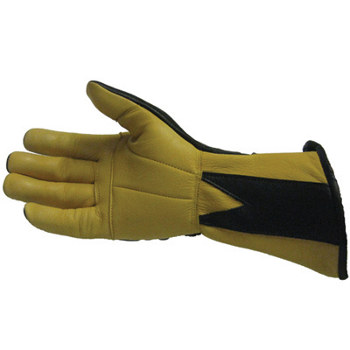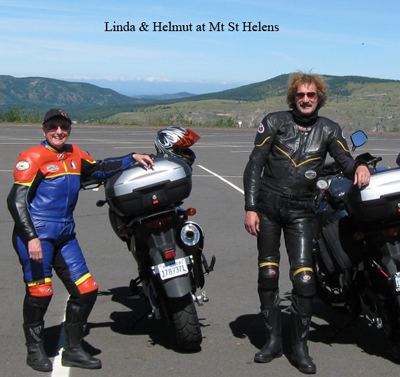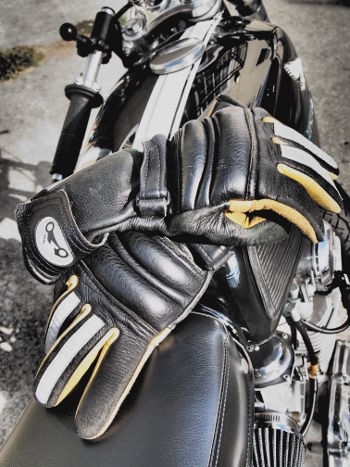Look at your fingers. Compare them to your arms and legs. Skinny little things, aren’t they? They break so easily, don’t they? So vulnerable. And just try riding a motorcycle without them.
And yet, almost every rider we see spends way less than $50 on gloves, and I’m among them, with bins of cheap gloves cluttering my garage shelves. Gloves still stiff from the package, never worn enough to break in.
That’s because I, like you, have some great pairs of go-to gloves I wear every day. One pair is the Helimot Buffalo Pro all-season gloves, ($210). It’s an all-deerhide, full-gauntlet design based on Helimot’s 365 glove, but with some more protective features from Helimot’s H20 racing design. That means it retains the comfort and street features of the 365, like the index-finger squeegee and reflective tape, with racing features like the retaining strap, pre-curved fingers and memory-foam armor over the fingers and knuckles.
Here’s the thing about a pair of Helimot gloves—if they fit you, they require almost no break in, wear like iron and are incredibly comfortable. If they don’t fit, try on a different pair—these are hand-crafted in Helimot’s Fremont, California facility and vary slightly from glove to glove. Helimot will also custom-size the fingers once break-in is complete.
Constructed with no liner out of durable USA deerskin, my Buffalo Pros are everything a glove should be. They are warm (or cool) enough to be usable in a broad temperature range (from the 50s to the low 80s, which covers about 10 months of the year here in the Bay Area), and use construction techniques and armor that Helimot co-founder Helmut Kluckner knows will protect you. Contrast that with your average pair of “top-of-the-line” race gloves from the big brands that cost the same, are made in China, are covered with complex features and “systems,” yet often burst apart the moment they touch the pavement.
Complaints are few and minor. To be comfortable, they must fit perfectly, which may not be so good if you’re mail-ordering, but Helimot will bend over backwards to get you a good fit. And the little leather squeegee on the left index finger doesn’t do much more than the leather of the finger itself. Nice idea, though.
Still, for fit, comfort, protection and sensible, no-nonsense style, you can’t beat these. They are pricey but will pay for themselves by lasting far longer than cheap (or even expensive) gloves. It’s like buying tiny custom leathers for your fingers. You like your fingers, don’t you? Put good gloves on them.
Visit the Helimot website for info on gloves, custom leathers and other products.
WORDS WITH Helimot’s Helmut Kluckner
MD Contributor John Joss sat down with Helimot’s Helmut Kluckner to find out more about gloves. Here are some of the highlights, but if you have questions about gloves, leathers, body armor or riding apparel in general, call Helimot at 510/252-1509, or visit the website.
MD: What should a rider look for in gloves?
Helmut: Beyond fit, does the palm area have enough protection? Is finger and knuckle protection incorporated? Are seams minimized? Will the gloves discolor the hands? Then—essential—will the manufacturer undertake repairs? It’s less costly than replacement, with well-designed gloves.
MD: What problems have you seen with gloves in crashes?
Helmut: Carbon fiber often grinds down, the fingers rotate and tear, the palms shows holes, thumbs are often ground through and many pieces are shredded. Many such gloves are not repairable.
MD: What about materials choices and compromises?
Helmut: Most gloves are cowhide, kangaroo, sheepskin or deerskin—each must be stitched differently. Each behaves differently. Cowhide stretches a little, kangaroo hardly stretches and deerskin stretches more over time.
Colorfast leathers cost more. Thickness matters. Thick hides give more abrasion resistance, but in a small thing like a glove it’s hard to stitch and work, turning the glove after stitching, given fit and feel on the hand. Riders like to ‘feel’ what the bike is doing through the bars so thickness must be controlled carefully.
It’s a trade-off. Thin skins give good feel but abrasion resistance drops (even kangaroo—it’s not a magic skin). Skins absorb sweat and heat differently. Sweat rots leather. Second season, maybe end of first season, a racer is using gloves that should be tossed. He falls and the glove blows up, not because it’s a bad glove but from sweat. He says: “See how those [Brand X] gloves came apart? [Brand X] must make terrible gloves.” Maybe it had bad construction, leather, whatever, maybe not.
Twenty years ago most gloves were plain leather. Racers loved them. It was just how they were made and how they felt. Some companies started to use more layers and more foam. Foam replaced studs and worked better. Media coverage forced manufacturers to think more about safety.
Sadly, we see riders with, yes, gardening gloves, riding $15,000 bikes, too frugal to protect their hands with $200 gloves. A strange economy.
MD: How does a rider pick the ‘one pair’ he or she needs for racing, sport riding and touring?
Helmut: Riders who trust the company they’re dealing with may get the gloves they want if the salesperson is knowledgeable. For touring and winter riding, leave room for inner gloves. The bottom line with all gloves is this: the pavement doesn’t care. Most gloves look good until the pavement judges their performance.










I’ve had a pair of the Buffalo 365 gloves for 8 years now. No crashes in them, so I can’t comment on their crash-worthiness, but they’ve lasted and lasted and lasted and remain extremely comfortable.
When I lived in California during the first year I owned these gloves, I wore them for commuting and touring and a couple of track days. Probably rode over 10,000 miles wearing them. After moving to the east coast, they’ve seen less use but perhaps more abuse in rain, sleet and salt. I wash them a few times a year and then apply leather conditioner. There’s a bit of a tear starting at one of the gauntlets due to the years of pulling on them while putting them on, but the reinforced piece of leather at that location has done its job.
For racing and track days, I’ve gone through several pairs of gloves and each pair of them cost more than $200. One pair of Alpinestars GP Pros has had failed seams (without a crash) and has been repaired twice – I only have them as a backups now. My current ones, from RS Taichi, seem to be holding up better.
None of my race gloves feel as well-made as the Buffalo 365s. There are fewer seams on the Helimot gloves, and I think that, along with the high-quality leather, makes them worth well more than their price tag. I’ll probably pick up a new pair next season.
I used to think like you about gloves but while racing in my 20s and having some other brand glove failures in relative minor crashes that resulted in getting sand ground into my ripped open knuckles and blistered skin on my palm from sliding down the track.
Still to this day I have issues with those knuckles related to those injuries.
I wised up and started wearing Helmut’s gloves. I crashed while racing in Helmut’s gloves a lot harder crashes than the “other brand” gloves with NO injuries to my hands.
When I was young and invincible (and stupid!) I thought I was OK riding or racing with any sort of gloves. Now at 50, I am glad I wised up early because a lot of those little injuries from my youth are coming back to haunt me – and I am not that old yet!
I’ve never owned a $200 pair of gloves, buuuut I might. I’ve looked and almost lusted after some gloves but the protection was off knuckle, one finger too short, gaudy (usually). This guy might get some business. I’ve had to buy gloves midtrip account of poor fit that didn’t rear its head until a few days into a trip. I’d really like to get fitted and some really good fittin gloves might be the result. Made in America, great product, gotta try it. Christmas is coming.
USD200 for a pair of gloves. I do believe in quality, but my wallet and my thrifty demeanor does not agree with my taste for quality.
Good try.
Yet if you were looking at two different bikes to buy, and the price difference was only $200, and the more expensive bike was clearly better, I bet you wouldn’t even bat an eyelid over the decision.
I think lots of people look at it as paying $200 for a pair of gloves, and think that’s too much for a pair of gloves, after all I can get some gardening gloves for $10. Perhaps the value would be appreciated more if people realized they’re paying $200 for the continued use of their hands. I don’t know about you, but my hands are certainly worth more than $200.
Never have I owned MC gloves this expensive. In my youth I road raced wearing garden leather gloves. Crashed a few times and my gloves protected my hands. Many times of riding for 50 years I have had slow speed crashes and my $20-$30 gloves have protected my hands. I wear Nolan helmets, not Arai.
Two seasons ago I bought some Held Phantom gloves for Track Days with Stingray leather on the palm, finger and thumb. I have enjoyed them, and haven’t crash-tested them…knock on wood. They are very well constructed and with a twice-annual washing, they are holding up well. They cam highly recommended.
That being said I do love Deer Hide work gloves. I have three Vanson Leathers (two jackets and a one-piece); I appreciate well made – long lasting things, especially when it comes motorcycle gear and your survival is on the line (Arai Helmets).
These could be on the 2013 acquisition list
I’ve been wearing Helimot’s gloves for almost 25 years.
I wore them in several crashes on the race track and never have a glove failure.
I wear my Buffalo gloves daily and can’t imagine any other glove.
I try on other brands but they all feel cheap and lack the quality of construction and design of my Buffalo gloves.
Sure you can find other gloves that approach the quality of Helmut’s designs but they cost as much as or more than Helmut’s gloves and I KNOW Helmut’s gloves will protect me! Helmut’s customer service is top of the heap!
I’ve been enjoying my Buffalos for many years of daily commuting. I do have a different set of -admittedly cheaper- gloves I use for bitter cold (San Francisco Bay Area…) and rainy days with a heated liner. My Buffalos were well worth the cost. Good thing because I’d hate to have to spend that much very often.
-todd